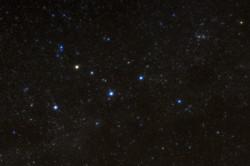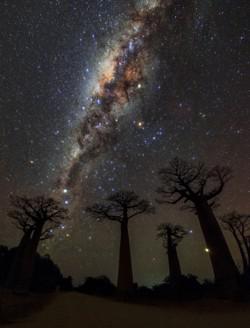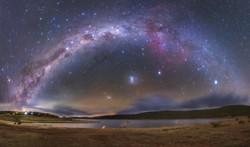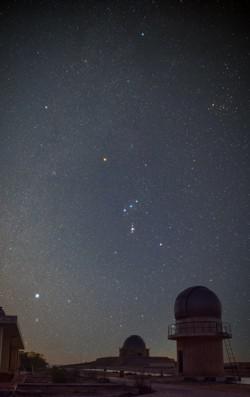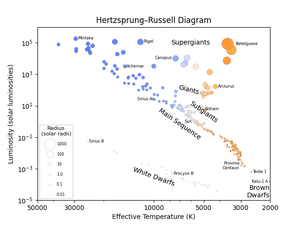Glossary term: Cor
Description: A cor de um objeto astronômico pode conter informações importantes sobre suas propriedades físicas. Mesmo a olho nu, uma estrela azulada que você vê no céu, como Alkaid no final da "alça" da Ursa Maior, será consideravelmente mais quente do que uma estrela avermelhada, como Betelgeuse no ombro de Orion. Para quantificar a cor, os astrônomos normalmente determinam o brilho de uma estrela quando vista através de um dos vários filtros azuis especializados possíveis e comparam com o brilho através de um filtro vermelho. Várias definições de cores distintas desse tipo, comparando o brilho em diferentes filtros específicos, estão em uso. Os resultados podem ser usados em análises estatísticas. Um exemplo são os diagramas de cor-magnitude, que representam a cor do objeto em relação ao brilho do objeto.
Related Terms:
See this term in other languages
Term and definition status: The original definition of this term in English have been approved by a research astronomer and a teacher The translation of this term and its definition is still awaiting approval
The OAE Multilingual Glossary is a project of the IAU Office of Astronomy for Education (OAE) in collaboration with the IAU Office of Astronomy Outreach (OAO). The terms and definitions were chosen, written and reviewed by a collective effort from the OAE, the OAE Centers and Nodes, the OAE National Astronomy Education Coordinators (NAECs) and other volunteers. You can find a full list of credits here. All glossary terms and their definitions are released under a Creative Commons CC BY-4.0 license and should be credited to "IAU OAE".
If you notice a factual or translation error in this glossary term or definition then please get in touch.
Related Media
Portrait of a Bat
Credit: Thanakrit Santikunaporn/IAU OAE
License: CC-BY-4.0 Creative Commons Attribution 4.0 International (CC BY 4.0) icons
Milky Way over Avenue of Baobabs
Credit: Amirreza Kamkar/IAU OAE
License: CC-BY-4.0 Creative Commons Attribution 4.0 International (CC BY 4.0) icons
Watchtower and Paddy Fields Under the Starry Sky
Credit: Likai Lin/IAU OAE
License: CC-BY-4.0 Creative Commons Attribution 4.0 International (CC BY 4.0) icons
The Milky Way Over Anglers Reach
Credit: Lucy Yunxi Hu/IAU OAE
License: CC-BY-4.0 Creative Commons Attribution 4.0 International (CC BY 4.0) icons
Winter Constellations
Credit: Mohamed Aboushelib/IAU OAE
License: CC-BY-4.0 Creative Commons Attribution 4.0 International (CC BY 4.0) icons
Related Diagrams
Hertzsprung-Russell diagram
Credit: IAU OAE/Niall Deacon
License: CC-BY-4.0 Creative Commons Attribution 4.0 International (CC BY 4.0) icons
Related Activities
Reading the Rainbow
astroEDU educational activity (links to astroEDU website) Description: By understanding how rainbows work, you can discover about light and its properties, learning about stars, nebulae, galaxies, and our Universe.
License: CC-BY-4.0 Creative Commons Attribution 4.0 International (CC BY 4.0) icons
Age Ranges:
14-16
, 16-19
, 19+
Education Level:
Informal
, Middle School
, Secondary
, University
Areas of Learning:
Interactive Lecture
, Observation based
, Social Research
Costs:
Low Cost
Duration:
1 hour 30 mins
Group Size:
Group
Skills:
Analysing and interpreting data
, Asking questions
, Engaging in argument from evidence
